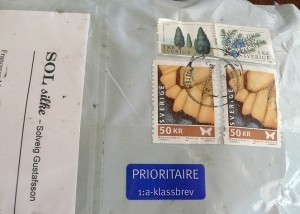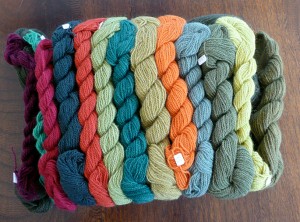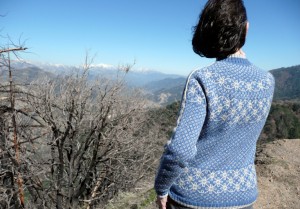
Blueprint pullover
is finished, just in time for what turned out to be our first summer day. I should have known.
Blueprint è finito, appena in tempo per la prima giornata estiva. Me lo potevo immaginare. 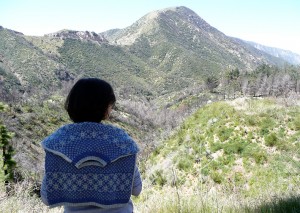
April's Fool gave us a summer day
We went to the
Mount Wilson Observatory for a day
out and I took the opportunity to get some photos. The observatory is in the Angeles Forest, an area devastated by fires a year and a half ago, the signs of which were evident throughout our trip. Charred trees, some black, others silvery or almost white after being stripped of their bark. Conifers reduced to vertical sticks are sprouting new growth on the trunk and resemble giant pipe cleaners. Ieri siamo andati all’osservatorio di Mount Wilson e ne ho approfittato per farmi fare alcune foto da Ben. L’osservatorio si trova nella Angeles Forest, un’area devastata dagli incendi un anno e mezzo fa e che porterà i segni dello scempio ancora per molto tempo. Alberi carbonizzati, alcuni completamente neri, altri argentati o quasi bianchi dopo che hanno perso la corteccia. Abeti ridotti a stecchini con nuovi ciuffi di vegetazione attaccati al tronco sembrano degli scavolini giganti.
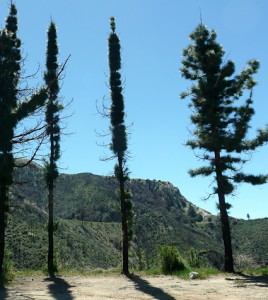
Giant pipe cleaners
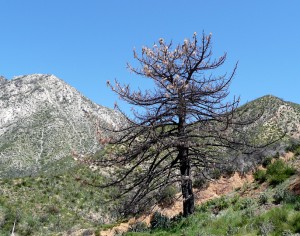
Still majestic
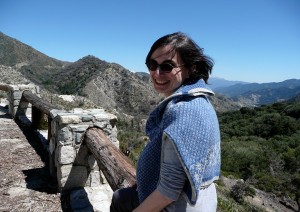
On the way to Mt. Wilson's Observatory
But among the dead trees, new vegetation has already covered most of the mountains. The Angeles Forest is an odd medley of Alpine and desert plants, resin-scented conifers next to yucca plants, cacti and the occasional palm tree. Some desert seeds actually require fire to crack open and start the propagation process, so after a fire it’s not unusual to see an explosion of desert plants.
Ma fra gli alberi secchi nuovi arbusti e fiori hanno già ricoperto gran parte delle montagne. La Angeles Forest è uno strano miscuglio di piante alpine e desertiche, conifere resinose accanto alle yucca, i cactus e le palme. Certe piante del deserto richiedono l’azione del fuoco per aprire i semi e favorire la propagazione per cui non è insolito dopo un incendio vedere un’esplosione di piante e fiori. 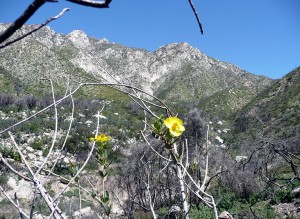
A few surprising yellow flowers among the dead trees
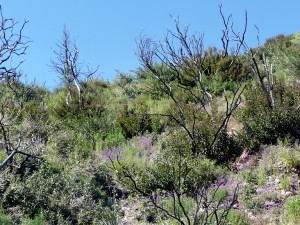
and some purple ones in clusters
But back to Blueprint. Early on in the project, the name
blueprint popped into my head and stuck. It may have been because of the colors — sugar paper blue and light gray — but it ended up describing what this sweater has meant for me over the past several weeks. It has become a sort of prototype for the design process while I improvised, frogged, tinked, cut, struggled with the inevitable math of color work and recalcitrant software that will not understand what I want when I build charts and schematics at the computer.
Ma tornando alla maglia… Fin dall’inizio ho pensato alla maglia come “blueprint”, forse per i colori — blu carta da zucchero e grigio chiaro — che mi ricordano le cianografie. Poi il termine blueprint ha acquisito un altro significato perchè questo progetto è diventato una specie di prototipo per il mio processo creativo mentre facevo, disfavo, tagliavo e facevo a botte con la matematica inevitabile dei motivi a colori e il software che si rifiuta di capire quello che voglio quando cerco di costruire diagrammi e schemi al computer. At first I charted the motifs and recorded my method just for myself; then decided to write a proper pattern. Who knows, there may be an audience out there of say, at least seven knitters worldwide who would consider knitting a sweater at this gauge. You don’t think so? There is even a group on Ravelry called
Tiny Needles. I am feeling optimistic. So that’s what I am doing now: refining the pattern while I work on a hat to match the sweater.
All’inizio ho fatto i diagrammi e annotato le varie operazioni per me; poi ho deciso di scrivere un modello come si deve. Chissà, magari c’è qualcun altro disposto a fare una maglia coi ferri a 2.5 mm. No? C’è perfino un gruppo su Ravelry chiamato “Tiny Needles” per gli altri suonati come me. Mi sento ottimista. Quindi il prossimo passo è finire il modello mentre faccio un berretto da abbinare alla maglia.
Posted by Francesca
